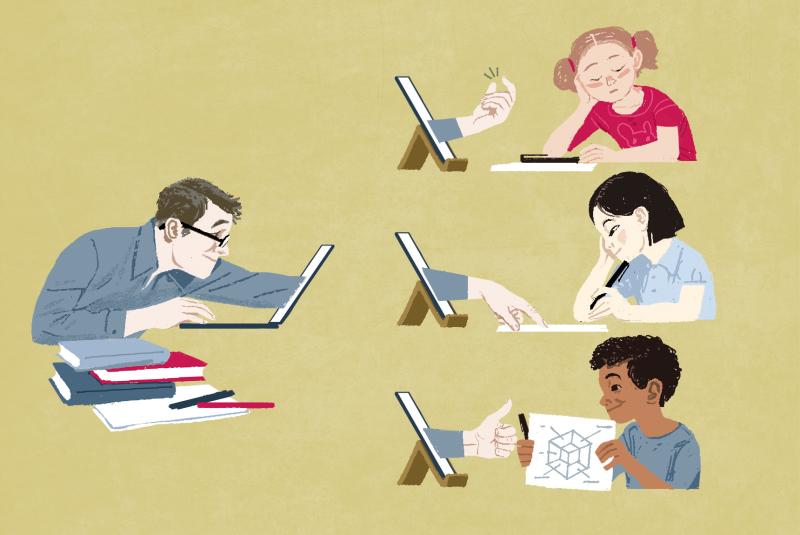Due to technological advancements and rising demand for flexible learning options, distance learning and online learning are two educational approaches that have garnered popularity. Although frequently used interchangeably, these terms have distinguishing characteristics. Distance learning is an educational format in which students and instructors are physically separated. Learning materials and communication occur via various channels, such as postal mail, email, telephone, and video conferencing. Even before the advent of the Internet, this method has existed for centuries. Distance learning can involve synchronous (real-time) and asynchronous (not real-time) interactions and may or may not necessitate digital technologies.
Conversely, online learning is a subset of distance learning that employs digital technologies and the Internet to disseminate course content, facilitate student interaction, and evaluate their progress. Students typically access course materials, complete assignments, and participate in discussions independently. It may also include synchronous components like live webinars and virtual classes. The key difference between distance learning and online learning is the mode of dissemination and interaction. Online learning focuses on using digital technologies and the Internet to facilitate education, whereas distance learning encompasses various methods, including non-digital formats.
What is Distance Learning?
Distance learning is a way of teaching that lets students learn without being in a traditional classroom. This way of learning is meant to be flexible and easy to use, so it can meet the needs of different learners who may be limited by their location, time, or other factors. In distance learning, course materials are sent through various methods, such as mail, email, phone, audio recordings, video conferencing, or digital platforms. Through these channels, students get learning tools, do their homework, and talk to their teachers and other students. Distance learning can involve synchronous (in real-time) and asynchronous (not in real-time) interactions based on how people communicate and how the lessons are set up.
An important part of distance learning is the need for good ways to communicate and get help. To keep students motivated and on track, instructors should give clear instructions, provide timely comments, and get them involved. To do well in this format, learners must also be self-disciplined, know how to handle their time and work independently. Distance learning has existed for hundreds of years, long before the Internet. But technological changes have made using and reaching more people much easier. Today, there are many kinds of distance learning, such as online learning, which uses digital tools and the Internet to help people learn.
What is Online Learning?
Online learning is a new way to teach that uses digital technologies and the Internet to deliver course material, make it easier for students to talk to each other, and check on their progress. It is a type of distance learning that focuses on giving learners who may be limited by location, time, or other factors the freedom, convenience, and access they need. In online learning, students use digital tools like Learning Management Systems (LMS), online forums, or websites to get access to educational materials, take part in discussions, and turn in assignments. This method usually involves asynchronous learning, which lets students go through the course materials at their own pace and doesn’t require them to talk to each other in real-time. But online learning can also include live webinars, virtual classes, or video conferences that let people work together and talk in real time.
Using technology well to create exciting and dynamic learning experiences is integral to online learning. Multimedia tools like videos, audio records, simulations, and interactive quizzes are used by teachers to help students learn more. On the other hand, students need to be self-motivated and know how to use technology well to do well in this method. Online learning has many perks, such as lower costs, more personalised learning, and the ability to work with different ways of learning. To be successful, you also need a good internet connection, access to digital devices, and the ability to organise your time well.
Difference Between Distance Learning and Online Learning
Distance learning is a method of teaching in which the student and teacher are geographically separated but remain in constant contact through other means, such as mail, email, telephone, or video conference. It can entail real-time or asynchronous communication, encompassing digital and non-digital approaches. As a subset of distance learning, online learning is distinguished by its exclusive reliance on the Internet for disseminating, discussing, and evaluating course materials. Students often learn independently at their own pace through asynchronous means; however, synchronous components are also possible. Distance learning encompasses a broader spectrum, while online learning places a premium on digital technologies as the primary form of delivery and interaction. Below you will find an explanation of the primary differences between online and distance learning.
Mode of Delivery
Mail, phone, and electronic mail are ways to transmit and receive content and conversation in a distance learning setting. Online learning relies entirely on digital technologies and the Internet when distributing course content and facilitating interactions.
Use of Technology
While distance learning may use both digital and non-digital formats, online learning exclusively uses digital resources, including LMSs, multimedia materials, and asynchronous discussion boards.
Synchronous vs Asynchronous
Distance learning is possible in synchronous (in real-time) and asynchronous (not in real-time) interactions. Online schooling, on the other hand, emphasises asynchronous learning while also incorporating synchronous components like live webinars and virtual courses.
Accessibility
Distance learning, which may be available to students with limited technology resources since it might include non-digital means, is distinct from online learning, necessitating a stable internet connection and access to digital devices.
Course Materials
Online learning uses entirely digital resources like e-books, videos, and interactive simulations, whereas distance learning may use both physical and digital copies of course materials.
Communication
Mail, phone, email, and internet-based video conferences are all viable options for distance learning. Email, message boards, and live chat are common digital channels used in distance learning.
History
Although online learning has only existed since the emergence of comprehensive digital technologies and the Internet, its predecessor, distance learning, dates back millennia.






